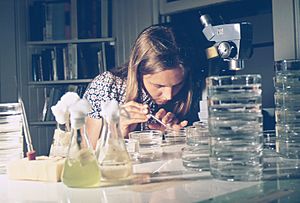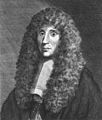Biologist facts for kids
A biologist is a scientist who studies biology. Biology is the study of all living things, like plants, animals, and even tiny bacteria. Biologists learn how living things work, grow, and interact with their environment.
There are many different types of biologists. Some study animals in the ocean, while others look at very small viruses or bacteria. Some biologists even study the DNA inside cells. Other biologists use living cells to create new products in factories or companies. This field is called biotechnology.
Contents
What Do Biologists Study?
Most biologists choose to focus on a specific area of study. They might specialize in one type of living thing or a particular activity. Here are some examples of what different biologists study:
Animal and Plant Experts
- Zoologists study animals. They learn about how animals behave, where they come from, and what diseases they might get. Some zoologists watch animals in their natural homes. Others might study animal bodies to understand their structure.
- Ornithologists study birds.
- Mammalogists study mammals.
- Herpetologists study reptiles and amphibians.
- Ichthyologists study fish.
- Entomologists study insects.
- Botanists study plants and their environments. They look at all kinds of plants, from tiny mosses to giant conifers and flowering plants. Botanists might study how plants grow, what makes them sick, or how they interact with other living things.
- Mycologists study fungi, like yeasts, molds, and mushrooms. Fungi are a separate group from plants.
Tiny Life and Body Systems
- Microbiologists study very tiny living things. These include bacteria, algae, and fungi. Many microbiologists use biotechnology to learn more about how cells reproduce and how human diseases work.
- Virologists study viruses.
- Immunologists study how our bodies fight off infections.
- Physiologists study how living things work. They look at how plants and animals perform life functions like growth, reproduction, and movement. They might study these functions in a whole organism or at a very small level, like inside a cell.
- Neuroscientists study the nervous system. This includes the brain, spinal cord, and nerves. They learn how these parts help us think, feel, and move.
Chemicals and Genes
- Biochemists study the chemicals that make up living things. They look at the complex chemical reactions involved in how organisms get energy (metabolism), reproduce, and grow.
- Molecular biologists study the activities between the tiny molecules inside living cells.
- Geneticists study genetics. This is the science of genes, how traits are passed down from parents to children (heredity), and why there are differences (variation) among living things.
Environment and Technology
- Ecologists study how living things interact with each other and their environment. They look at things like population size, pollution, rainfall, and temperature. Ecologists often collect data on the quality of air, food, soil, and water.
- Aquatic biologists study living things that live in water.
- Marine biologists study organisms that live in salt water, like oceans.
- Limnologists study organisms that live in fresh water, like lakes and rivers.
- Biophysicists study how physics relates to living cells and organisms. They look at things like electrical and mechanical energy in living systems.
- Computational biologists use computers and math to solve biological problems. They create mathematical models and computer simulations to understand biological processes without needing a lab.
Images for kids
-
Nobel Prize-winning biologist Barbara McClintock.
-
Francesco Redi, an early biologist.
-
Martinus Willem Beijerinck, a famous botanist and microbiologist.
-
Charles Darwin was a very famous biologist.
See also
 In Spanish: Biólogo para niños
In Spanish: Biólogo para niños







